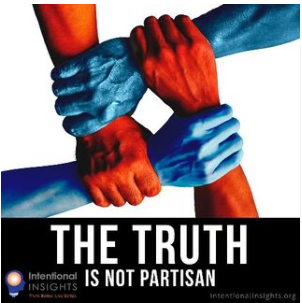
Caption: Couples in argument Pointing fingers at each other (Kick Ads/Used with Permission)
We frequently use debates to resolve different opinions about the truth. However, debates are not always the best course for figuring out the truth. In more emotionally charged situations, the technique of collaborative truth-seeking is often better.
The Problem with Debates
The usual method of hashing out disagreements in order to discover the truth about reality is through debates, in person or online. Yet more often than not, people on opposing sides of a debate end up seeking to persuade rather than prioritizing truth discovery. Indeed, research suggests (link is external) that debates have a specific evolutionary function – not for discovering the truth but to ensure that our perspective prevails within a tribal social context. No wonder debates are often compared to wars (link is external). This is especially so in emotionally charged topics, such as politics, as our autopilot system (link is external) takes over and inhibits our ability to be rational in our engagement with others.
We may hope that we would strive to discover the truth during debates. Yet given that we are not always fully rational and strategic (link is external) in our social engagements, it is easy to slip up within debate mode and orient toward winning instead of uncovering the truth. Heck, I know that I sometimes forget in the midst of a heated debate that I may be the one who is wrong – I’d be surprised if this didn’t happen with you. So while we should certainly continue to engage in debates, we should also use additional strategies – less natural and intuitive ones. These strategies could put us in a better mindset for updating our beliefs and improving our perspective on the truth. One such solution is a mode of engagement called collaborative truth-seeking.
 Caption: Meme saying “The Truth Is Not Partisan” (Created by Lexie Holliday for Intentional Insights)
Caption: Meme saying “The Truth Is Not Partisan” (Created by Lexie Holliday for Intentional Insights)
Collaborative Truth-Seeking
Collaborative truth-seeking (link is external) is one way of describing a more intentional approach in which two or more people with different opinions engage in a process that focuses on finding out the truth. Collaborative truth-seeking is a modality that should be used among people with shared goals and a shared sense of trust.
Some important features of collaborative truth-seeking, which are often not present in debates, are: focusing on a desire to change one’s own mind toward the truth; a curious attitude; being sensitive to others’ emotions; striving to avoid arousing emotions that will hinder updating beliefs and truth discovery; and a trust that all other participants are doing the same. These can contribute to increased social sensitivity (link is external), which, together (link is external) with other attributes, correlate with accomplishing higher group performance on a variety of activities.
- Share weaknesses and uncertainties in your own position
- Share your biases about your position
- Share your social context and background as relevant to the discussion. For instance, I grew up poor once my family immigrated to the US when I was 10, and this naturally influences me to care about poverty more than some other issues, thus biasing me in this area
- Vocalize curiosity and the desire to learn
- Ask the other person to call you out if they think you’re getting emotional or engaging in emotive debate instead of collaborative truth-seeking, and consider using a safe word
Here are additional techniques that can help you stay in collaborative truth-seeking mode after establishing trust:
- Self-signal: signal to yourself that you want to engage in collaborative truth-seeking, instead of debating
- Empathize: try to empathize with the other perspective that you do not hold by considering where their viewpoint came from, why they think what they do, and recognizing that they feel that their viewpoint is correct
- Keep calm: be prepared with emotional management to calm your emotions and those of the people you engage with when a desire for debate arises. Watch out for defensiveness and aggressiveness in particular
- Go slow: take the time to listen fully and think fully
- Consider pausing: have an escape route for complex thoughts and emotions if you can’t deal with them in the moment by pausing and picking up the discussion later. Say “I will take some time to think about this,” and/or write things down
- Echo: paraphrase the other person’s position to indicate and check whether you’ve fully understood their thoughts
- Be open: orient toward improving the other person’s points to argue against their strongest form (link is external)
- Stay the course: be passionate about wanting to update your beliefs, maintain the most truthful perspective, and adopt the best evidence and arguments, no matter if they are yours of those of others
- Be diplomatic: when you think the other person is wrong, strive to avoid saying “you’re wrong because of X” but instead to use questions, such as “what do you think X implies about your argument?”
- Be specific and concrete: go down levels of abstraction (link is external)
- Be clear: make sure the semantics are clear to all by defining terms. Consider tabooing terms (link is external) if some are emotionally arousing, and make sure you are describing the same territory of reality (link is external)
- Be probabilistic: use probabilistic thinking (link is external) and probabilistic language, to help get at the extent of disagreement and be as specific and concrete as possible. For instance, avoid saying that X is absolutely true, but say that you think there’s an 80% chance it’s the true position. Consider adding what evidence and reasoning led you to believe so, for both you and the other participants to examine this chain of thought
- When people whose perspective you respect fail to update their beliefs in response to your clear chain of reasoning and evidence, update a little somewhat toward their position, since that presents evidence that your position is not very convincing
- Confirm your sources: look up information when it’s possible to do so (Google is your friend)
- Charity mode: try to be more charitable to others and their expertise than seems intuitive to you, as our intuitions are a bad guide to seeking the truth when the person with whom we are in discussion has a perspective different from our own. For instance, if someone says something that seems wrong to you, check to make sure that is what the person actually said – you might have misheard things, or the person might have misstated something
- Use the reversal test (link is external) to check for status quo bias: If you are discussing whether to change some specific numeric parameter – say increase by 50% the money donated to charity X – state the reverse of your positions, for example decreasing the amount of money donated to charity X by 50%, and see how that impacts your perspective
- Use CFAR’s double crux (link is external) technique. In this technique, two parties who hold different positions on an argument each writes the the fundamental reason for their position (the crux of their position). This reason has to be the key one, so if it was proven incorrect, then each would change their perspective. Then, look for experiments that can test the crux. Repeat as needed. If a person identifies more than one reason as crucial, you can go through each as needed. More details are here (link is external).
- Finally, consider using this Collaborative Truth-Seeking web app to help you evaluate the quality and extent of evidence on each side.
Of course, not all of these techniques are necessary for high-quality collaborative truth-seeking. Some are easier than others, and different techniques apply better to different kinds of truth-seeking discussions. You can apply some of these techniques during debates as well, such as double crux and the reversal test. Try some out and see how they work for you.
Conclusion
Engaging in collaborative truth-seeking goes against our natural impulses to win in a debate, and is thus more cognitively costly. It also tends to take more time and effort than just debating. It is also easy to slip into debate mode even when using collaborative truth-seeking, because of the intuitive nature of debate mode.
Moreover, collaborative truth-seeking need not replace debates at all times. This non-intuitive mode of engagement can be chosen when discussing issues that relate to deeply-held beliefs and/or ones that risk emotional triggering for the people involved. Because of my own background, I would prefer to discuss poverty in collaborative truth-seeking mode rather than debate mode, for example. On such issues, collaborative truth-seeking can provide a shortcut to resolution, in comparison to protracted, tiring, and emotionally challenging debates.
Likewise, using collaborative truth-seeking to resolve differing opinions on all issues holds the danger of creating a community oriented excessively toward sensitivity to the perspectives of others, which might result in important issues not being discussed candidly. After all, research shows (link is external) the importance of having disagreement in order to make wise decisions and to figure out the truth. Of course, collaborative truth-seeking is well suited to expressing disagreements in a sensitive way, so if used appropriately, it might permit even people with triggers around certain topics to express their opinions.
Taking these caveats into consideration, collaborative truth-seeking is a great tool to use to discover the truth and to update our beliefs, as it can get past the high emotional barriers to altering our perspectives that have been put up by evolution.
Questions to Consider
- In the past, when do you wish you could have applied collaborative truth-seeking techniques?
- In what contexts would collaborative truth-seeking serve you well in the future?
- What might be challenges to your use of collaborative truth-seeking?
P.S. Tired of lies in politics? Take the Pro-Truth Pledge (link is external), a research-based strategy to get politicians and other public figures to tell more truth and less lies!




